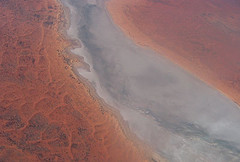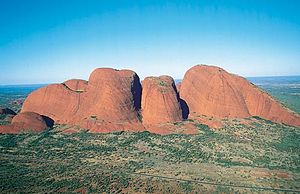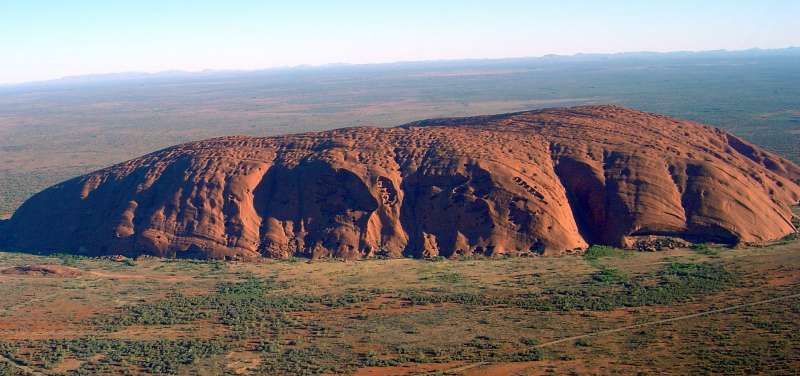
Turns out there are some differences and some similarities between these two formations, so I’ll have to talk about them separately. Both of these mountains are in the class of formations known as Inselbergs (from German meanings “island-mountains”). Many Inselbergs are granite or other hard rocks that were left standing when the softer rock around was washed away. But what these two places I’ve chosen out (and others like them around the world) have in common is that the rock they are made of was pushed up from under the ground. They also (surprise, surprise) needed water around to help them take the form we see today. Interestingly, both of these monuments are in very dry areas today, so things must have been different in the past or they wouldn’t be here.
We’ll start with Uluru:
I first heard about how land formations like Uluru in Australia were formed from Dr. Walt Brown’s book. He has a lot to say about Uluru and explains how these kinds of formations are only possible with quiet water covering them. Do check his page out, he has some amazing pictures!
He calls sedimentary stone formations like these “liquifaction mounds (or plumes [if they’re skinny]).” Liquifaction takes up a large part of Dr. Brown’s book and he gets very detailed. Basically, water can hold a lot of tiny bits of rock under the right conditions, and then let them fall in a very quick and orderly way. We see layers like this everywhere in sedimentary rocks, usually laid down like sheets of pastry in a baklava or a Torte.
Here at Uluru, something different was happening as well. Uluru is made out of all different kinds of sand cemented together (I’m going to write more about cementing soon). Here’s what Wikipedia has to say about it, Uluru’s sandstones “show little sorting based on grain size, exhibit very little rounding and the feldspars in the rock are relatively fresh in appearance.” Feldspar is very common rock making up about 60% of the Earth. These bits of sand didn’t have a chance to get rounded like the sand along the ocean or a lake. This shows that they were freshly broken up from whatever rock they came from originally (probably granite) and didn’t spend very long being washed around in water before settling into their form today.
Wikipedia claims that Uluru formed from an “alluvial fan” which means a river delta. At least they got the water part right! But have you ever seen a delta with great humps of rock left behind without being worn right back down?

From Dr. Brown’s studies, it seems that layers of wet sand were caught underground with enough pressure to squeeze out of cracks up to the surface when there was a chance. He figures there were probably lots more of these muddy piles formed during the Flood, but most of them were washed away by the water sloshing around. But where Uluru is, there was an area of trapped, quiet water which gave the sand time to cement into stone. We know that there was a water basin there because the salt bed, now called Lake Amadeus, that these kinds of Flood-water-lakes leave behind is just 31miles [50km] away down the valley.
If you look at Dr. Brown’s page and this page of Uluru’s 36 sister mounds The Olgas-Kata Tjuta (25km [16mi] to the west of Uluru) you will see something very interesting about these rocks. They once had acne really badly! Or, rather, they are filled with pock marks all around the sides.

This is what Think Quest is telling kids about Uluru: They start with the “500 million years” bit, then mention that it was formed underwater! I picked this page (because it would load!) and because it mentions that the Aborigines remember that Uluru was once in an ocean. Just what we were expecting! Wikipedia also mentions that the locals have a story of the rock being formed from mud, but the rest of the legends are not very nice, so I don’t encourage you to read them yet.
He putteth forth his hand upon the rock; he overturneth the mountains by the roots. He cutteth out rivers among the rocks; and his eye seeth every precious thing. He bindeth the floods from overflowing; and the thing that is hid bringeth he forth to light. Job 28:9-11






